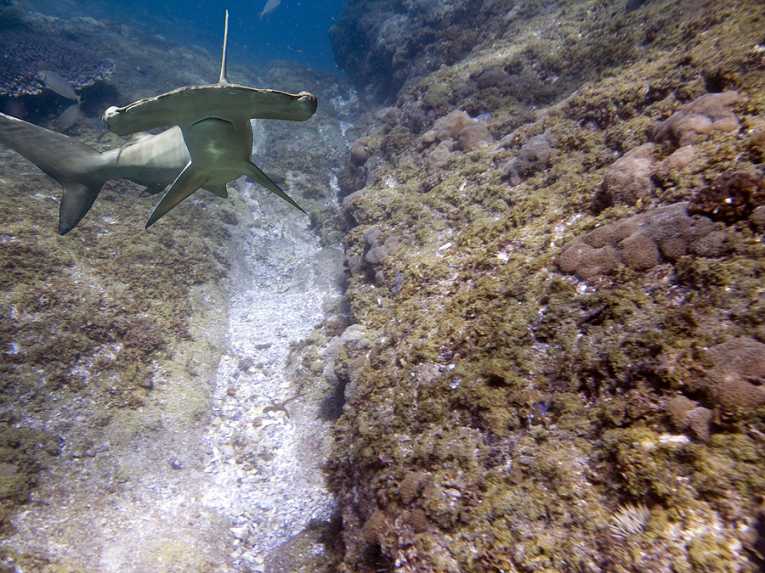The President of the Marshall Islands, Jurelang Zedkaia, declared the world's biggest shark sanctuary on October 2nd. The parliament or Nitijela unanimously passed a law prohibiting commercial shark fishing in the two million km2 piece of ocean surrounding the Pacific islands.
Several legislative moves have recently affected shark fishing. In particular, the monitoring of all vessels that forces them to land their catch at one of the country's ports should help the cause of many species of sharks and rays. In July, a complete ban on shark fishing and fin removal was announced in all the islands.

Image Credit: Marshall Islands National Shark Sanctuary Map © Pew Environment Group
Matt Rand is the shark conservation director for Pew, which began 20 years ago as a charity deriving their funds from the Pew family of Sun Oil fame. His comment on this latest of many successes in Micronesia and worldwide was, 'We salute the Republic of the Marshall Islands for enacting the strongest legislation to protect sharks that we have seen.' One of the reasons the Marshalls have taken such action is obvious to fish-eaters. The locals claim that the reef sharks control fish numbers on the atolls. If larger fish are not eaten, then the food chain is affected by the massacre of smaller fish. These fish are needed for the jobs undertaken at the base of the food pyramid. Algae-scraping is essential to maintain coral; plankton-eaters prevent blooms of the ocean plant life. And the people who eat their fish suppers locally love their favourite species. They could all disappear if the sharks can't do their job.

Image Credit: Shark finning © Jeff Rotman
Palau, the Maldives, Honduras, the Bahamas and Tokelau have also declared shark sanctuaries, while Mexico, inspired by Palau's initiative in 2009, are banning shark and ray fishing as from next year and Colombia is waiting to implement similar laws. Chile has already banned the landing of sharks whose fins are not attached 'naturally' to the animal.
The history of shark fishing is devoid of normal protection for an animal which is also a vital resource. Most useful and obvious as a top predator in the ocean, rays, skates, angel sharks and open water species cover a vast and diverse array of niches throughout the marine ecosystems. One of the most ancient fish groups, these species are so adapted to their habitats that some have survived successfully, almost unchanged, for 400 million years. Even in the sea, that achievement is almost unmatched.

Image Credit: Shark fin soup can cost US$100 © Michael James Kavanagh
Shark fins began being taken many centuries ago, for the almost tasteless soup that Chinese people regard as a status statement. The huge growth in this trade very recently has prompted a lot of measures to prevent extinction of certain species. For example, the Scalloped Hammerhead (Sphyma leweni) population has been reduced by 98-99%, leaving it more than vulnerable to any climatic or human change. Success depends on effectiveness of these measures and how many other countries will join the campaign to prevent irresponsible attitudes to natural resources.
Manta birostrisis the largest ray, but only recently revealed it is in fact two separate species. Work is urgently needed to find the specific differences, in case one species is in danger. Rays are among the most popular fish in aquaria because of their adaptive "tameness."

Image: Manta Ray; Credit: © Fiona Ayerst
The useful bottom-dweller called the angel shark is rarely seen, especially with such beautiful camouflage, except when dredged up, but has many species which are critically endangered. You may never see one, without gigantic efforts on our protection of marine habitats.

Image Credit: Angel Shark © Philippe Guillaume
Apart from the magnificent Hammerhead spp., other sharks in need of rapid help are the blue shark and even the biggest sharks - the whale shark (Rhincodon typus).

Image Credit: Whale Shark © DJ Mattaar
and Basking Shark (Cetorhinus maximus), which are harmless plankton feeders. The tourist dollar is very well invested in these last two, as tours form in order to follow progress when their huge forms are sighted in many countries. Let's hope fervently we will see sharks again, for if 400 million years can disappear without trace, then the portents can be read for the rest of our natural resources.

Image: Basking Shark © Greg Skomal/SWFSC-NOAA










